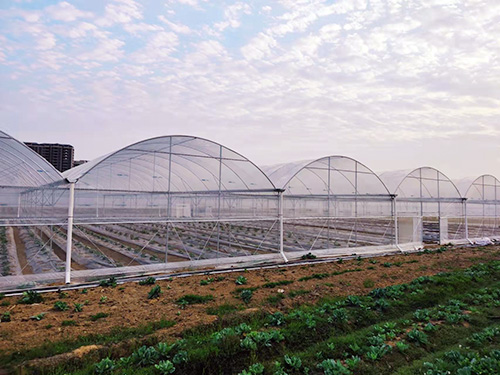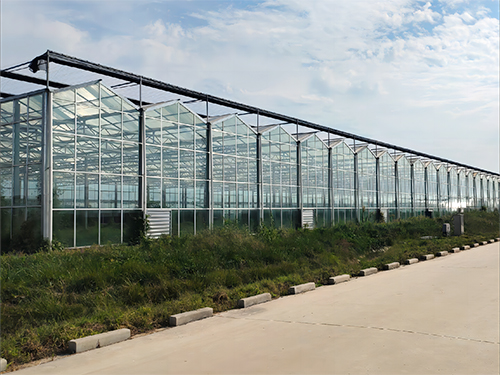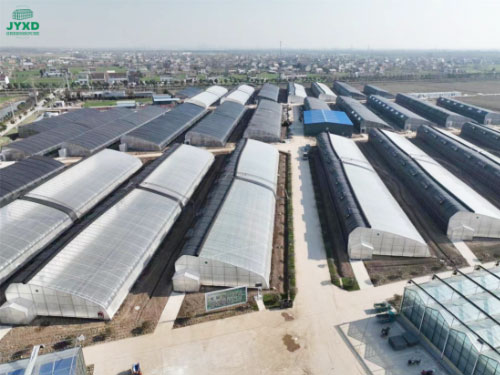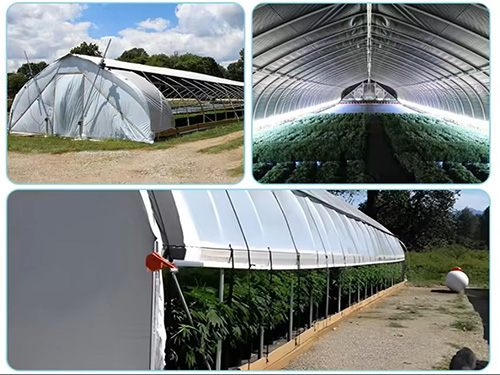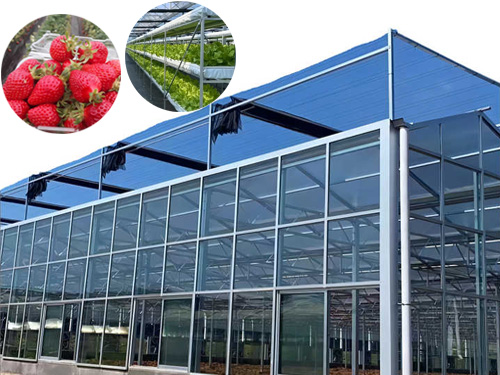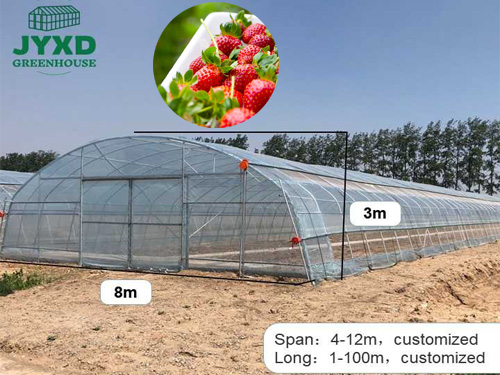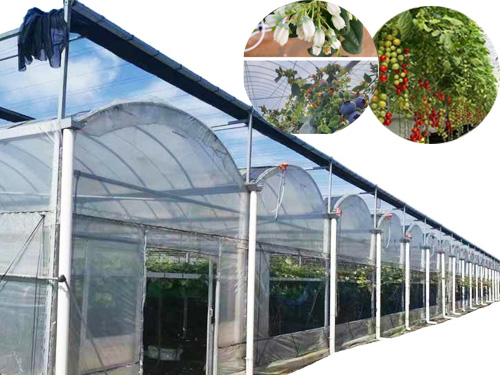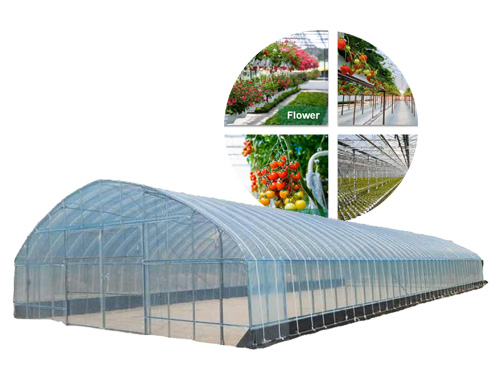NEWS DETAILS
NEWS INFORMATION
Greenhouse Blackout Film: A Powerful Tool for Enhancing Plant Growth and Crop Yields
AUTHOR:jyxd-greenhouse DATE:2024-12-03 00:21:12 HITS:187
In the world of greenhouse farming, controlling the environment is crucial for maximizing plant health and productivity. One of the most important factors for plant growth is light, but not all plants thrive in constant sunlight. In certain stages of growth, plants may require a reduction in light exposure to simulate specific environmental conditions. This is where greenhouse blackout film becomes invaluable. In this article, we will explore what greenhouse blackout film is, how it works, its benefits, and why it’s a must-have tool for many greenhouse growers.
What is Greenhouse Blackout Film?
Greenhouse blackout film is a specialized type of plastic film that is used to block out sunlight from entering the greenhouse. This type of film is typically made from black or opaque polyethylene, designed to reduce light exposure to plants by creating total darkness or a highly controlled light environment. Greenhouse blackout film is often used in commercial greenhouses and nurseries to manage light exposure, simulate seasonal changes, and optimize plant growth cycles.
The film can be used to either cover the entire greenhouse or specific sections of the structure, depending on the light control requirements of the crops being grown. Its versatility makes it an essential tool for growers aiming to manage the light and dark cycles of plants, particularly in the cultivation of high-value crops such as flowering plants, vegetables, and herbs.
Keywords: greenhouse blackout film, light control film, greenhouse light management, blackout film for plants
How Does Greenhouse Blackout Film Work?
Greenhouse blackout film works by preventing sunlight from passing through, effectively darkening the interior of the greenhouse. Here's how it achieves this:
1. Light Reduction
Blackout films are designed to block a significant portion of sunlight, creating an environment of darkness for plants. This is particularly useful for plants that require a specific light cycle, such as short-day or long-day plants. The film helps simulate natural seasonal light fluctuations, which can encourage flowering, fruiting, or other growth processes in certain crops.
2. Temperature Regulation
In addition to controlling light, greenhouse blackout film can also help with temperature regulation. During the day, sunlight can cause excessive heat buildup inside a greenhouse, especially in the summer months. The film reduces this direct sunlight exposure, helping to maintain a more consistent temperature inside the greenhouse, which can be particularly beneficial for temperature-sensitive plants.
3. Protection from UV Radiation
Many greenhouse blackout films are also designed to block harmful UV rays, protecting both plants and the greenhouse structure. UV radiation can cause plant stress and damage, reducing crop quality and yields. By blocking UV rays, blackout films help preserve the health of plants and extend the lifespan of the greenhouse.
Keywords: light cycle control, temperature regulation in greenhouse, UV protection film
Benefits of Using Greenhouse Blackout Film
The use of greenhouse blackout film offers several key benefits that can enhance plant growth, optimize growing conditions, and increase crop yields. Here are some of the most notable advantages:
1. Enhanced Control Over Photoperiods
Some plants, like flowering plants and vegetables such as tomatoes and cucumbers, rely on specific light periods to trigger certain growth stages. Blackout films allow growers to control the photoperiod by limiting light exposure, which can stimulate flowering or fruiting at the right time. This is especially important for plants grown for market harvests or those requiring precise environmental conditions to achieve optimal results.
2. Improved Energy Efficiency
By blocking excess sunlight, greenhouse blackout films can also help reduce the need for cooling systems during hot weather. With less direct sunlight entering the greenhouse, internal temperatures are better regulated, which can lower the need for artificial cooling. This leads to reduced energy costs, making it a more energy-efficient way of managing temperature and light conditions.
3. Optimized Growth for Sensitive Crops
Certain crops, such as leafy greens (like lettuce and spinach) or herbs, are sensitive to light intensity and may require less light for optimal growth. Blackout films can be used to simulate the conditions these plants would encounter in their natural habitat, ensuring they thrive and grow at their optimal pace. Additionally, plants like cucumbers, peppers, and tomatoes can benefit from light reduction during their flowering phase, which helps prevent overstimulation and improves fruit quality.
4. Prevention of Overheating
During hot summer months, greenhouses can quickly become overheated due to the accumulation of sunlight. By using greenhouse blackout films, the direct sunlight entering the structure is minimized, which helps keep the temperature at an ideal level. This is especially important in regions with extreme heat, where temperature control can be a challenge. Blackout films help to maintain a cooler and more comfortable environment for both plants and workers.
5. Protection Against Light Pollution
In some areas, especially near urban developments, light pollution from external sources (streetlights, buildings, etc.) can interfere with the natural light cycle in a greenhouse. Blackout films provide an effective solution by blocking all external light, ensuring that plants experience the correct day-night rhythm needed for proper growth.
Keywords: photoperiod control, energy efficiency in greenhouses, growth optimization for sensitive crops, greenhouse overheating prevention
Applications of Greenhouse Blackout Film
Greenhouse blackout film can be applied in various agricultural settings, from small hobby greenhouses to large commercial operations. Here are some common applications:
1. Flowering Plants and Vegetables
Growers of flowering plants such as chrysanthemums, poinsettias, and geraniums often rely on blackout films to control the light exposure and induce flowering at the right time. Vegetables such as tomatoes, peppers, and eggplants also benefit from controlled light cycles, which can help improve yield and quality. Blackout films are ideal for these types of crops that require specific light conditions to thrive.
2. Nutrient-Dense Leafy Greens
Leafy greens like lettuce, spinach, and arugula are grown under controlled light conditions, where they benefit from light reduction to promote healthy leaf growth without excessive bolting. Blackout films can simulate the low-light conditions that these crops need to grow in optimal conditions.
3. Tropical Plants and Herbs
Tropical plants and herbs, such as basil, mint, and coriander, can also benefit from the use of blackout films. These plants thrive in environments with controlled light, and the ability to reduce sunlight exposure can help prevent leaf burn and promote lush growth.
4. Seasonal and Off-Season Crops
Blackout films are commonly used to extend the growing season for various crops by simulating the natural light conditions of the off-season. Growers can use the films to accelerate or delay growth cycles, enabling them to grow crops in non-ideal seasons or off-season markets.
Keywords: flowering plant growth, leafy greens production, tropical plant cultivation, off-season crop growing
How to Install Greenhouse Blackout Film
Installing greenhouse blackout film is relatively simple but requires careful attention to detail to ensure that it provides effective light control. Here’s how to install it:
1. Measure the Greenhouse: Measure the size of your greenhouse to determine how much blackout film you’ll need. Be sure to account for any overlaps or edges.
2. Prepare the Frame: Clean the greenhouse structure and check for any sharp edges that could damage the film.
3. Cut the Film to Size: Cut the blackout film to fit your greenhouse. Leave extra material on the edges to secure it properly.
4. Install the Film: Carefully roll the film over the structure, ensuring that it is aligned properly and taut. You can attach it using clips, ropes, or greenhouse film fasteners.
5. Ensure Proper Sealing: After installation, check for any gaps where light might leak through. Proper sealing ensures maximum effectiveness.
Keywords: blackout film installation, greenhouse film sealing, light management setup
Conclusion
Greenhouse blackout film is a versatile and powerful tool for growers seeking to optimize plant growth through light management. Whether you're controlling photoperiods, reducing heat buildup, protecting plants from excessive sunlight, or enhancing energy efficiency, blackout films provide a range of benefits that can significantly improve your crop yields and overall greenhouse performance. By using this specialized film, you can create the ideal environment for a wide variety of crops, ensuring healthy plants and maximum productivity.
Keywords: greenhouse blackout film, light management in greenhouses, crop yield improvement, light control, greenhouse energy efficiency
Hebei Juyou Xinda Greenhouse Facilities Co.,Ltd.
Copyright © 2024-2025 https://www.jyxd-greenhouse.com. All Rights Reserved Hebei Juyou Xinda Greenhouse Facilities Co.,Ltd.Copyright





 Current Location:
Current Location: